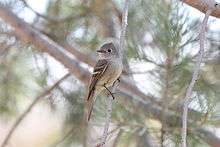Hammond's flycatcher
| Hammond's flycatcher | |
|---|---|
 | |
| Scientific classification | |
| Kingdom: | Animalia |
| Phylum: | Chordata |
| Class: | Aves |
| Order: | Passeriformes |
| Family: | Tyrannidae |
| Genus: | Empidonax |
| Species: | E. hammondii |
| Binomial name | |
| Empidonax hammondii (Xantus de Vesey, 1858) | |
Hammond's flycatcher, Empidonax hammondii is a small insect-eating bird. It is a small Empidonax flycatcher, with typical size ranging from 12.5-14.5 cm.
Adults have greyish-olive upperparts, darker on the wings and tail, with whitish underparts; they have a conspicuous white eye ring, white wing bars, a small bill and a short tail. The breast is washed with grey and the sides of the belly with yellow. Many species of Empidonax flycatchers look closely alike. The best way to distinguish species is by voice, breeding habitat and/or range.
Their preferred breeding habitat is coniferous forests in highlands of the western United States, Alaska and Canada. They make a cup nest on a fork in a tree, usually high in a horizontal branch. Females usually lay three or four eggs.
These birds migrate to Mexico and Central America for the winter.
They wait on an open perch high or in the middle of a tree and fly out to catch insects in flight, (hawking), also sometimes picking insects from foliage while hovering, (gleaning).
The song is a multi versed hoarse ssilit, greeep, silit, pweet. The call is a sharp peek.
The name of this bird commemorates William Alexander Hammond who was the surgeon general of the US Army. Hammond collected bird specimens for Spencer Fullerton Baird.[2]
References
- ↑ BirdLife International (2012). "Empidonax hammondii". IUCN Red List of Threatened Species. Version 2013.2. International Union for Conservation of Nature. Retrieved 26 November 2013.
- ↑ Beolens, Bo; Watkins, Michael (2003). Whose Bird? Men and Women Commemorated in the Common Names of Birds. London: Christopher Helm. p. 156.
External links
- Photo gallery - VIREO
- Photo; Article with photos – schmoker.org
